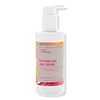What's inside
What's inside
 Key Ingredients
Key Ingredients

 Benefits
Benefits

 Concerns
Concerns

 Ingredients Side-by-side
Ingredients Side-by-side

Water
Skin ConditioningPanthenol
Skin ConditioningPropanediol
SolventCoco-Caprylate/Caprate
EmollientGlycerin
HumectantAmmonium Acryloyldimethyltaurate/Vp Copolymer
Glyceryl Glucoside
HumectantCaprylyl Glyceryl Ether
CleansingGlyceryl Stearate Se
EmulsifyingHydrogenated Lecithin
EmulsifyingPolyglutamic Acid
Skin ConditioningSodium Hyaluronate
HumectantCaprylhydroxamic Acid
Capryloyl Salicylic Acid
ExfoliatingBeta-Glucan
Skin ConditioningTrisodium Ethylenediamine Disuccinate
Water, Panthenol, Propanediol, Coco-Caprylate/Caprate, Glycerin, Ammonium Acryloyldimethyltaurate/Vp Copolymer, Glyceryl Glucoside, Caprylyl Glyceryl Ether, Glyceryl Stearate Se, Hydrogenated Lecithin, Polyglutamic Acid, Sodium Hyaluronate, Caprylhydroxamic Acid, Capryloyl Salicylic Acid, Beta-Glucan, Trisodium Ethylenediamine Disuccinate
Water
Skin ConditioningPropanediol
SolventCaprylic/Capric Triglyceride
MaskingIsopentyldiol
HumectantEthylhexyl Polyhydroxystearate
EmollientSqualane
EmollientTetradecane
PerfumingGlyceryl Stearate Citrate
EmollientButyrospermum Parkii Butter
Skin ConditioningPolyglyceryl-3 Stearate
EmulsifyingHelianthus Annuus Extract
EmollientOryza Sativa Bran Extract
Skin ConditioningMannitol
HumectantPhosphatidylcholine
EmulsifyingFerulic Acid
AntimicrobialArginine
MaskingAcetyl Hexapeptide-8
HumectantCopper Palmitoyl Heptapeptide-14
Skin ConditioningPalmitoyl Sh-Heptapeptide-12 Sp
Skin ConditioningHydrolyzed Collagen
EmollientRosmarinus Officinalis Leaf Extract
AntimicrobialLactic Acid/Glycolic Acid Copolymer
Skin ConditioningGlycerin
HumectantTocopherol
AntioxidantPullulan
Lysolecithin
EmulsifyingSclerotium Gum
Emulsion StabilisingHydroxyethyl Acrylate/Sodium Acryloyldimethyl Taurate Copolymer
Emulsion StabilisingDimethicone
EmollientSodium Phytate
Diglycerin
HumectantHydrogenated Lecithin
EmulsifyingSilica
AbrasiveCetyl Alcohol
EmollientHydroxyacetophenone
AntioxidantPolysorbate 60
EmulsifyingSorbitan Isostearate
EmulsifyingSodium Hydroxide
BufferingSodium Benzoate
MaskingPotassium Sorbate
PreservativePolyvinyl Alcohol
Decyl Glucoside
CleansingXanthan Gum
EmulsifyingTocopheryl Acetate
AntioxidantSodium Chloride
MaskingCitric Acid
BufferingPhenoxyethanol
PreservativeWater, Propanediol, Caprylic/Capric Triglyceride, Isopentyldiol, Ethylhexyl Polyhydroxystearate, Squalane, Tetradecane, Glyceryl Stearate Citrate, Butyrospermum Parkii Butter, Polyglyceryl-3 Stearate, Helianthus Annuus Extract, Oryza Sativa Bran Extract, Mannitol, Phosphatidylcholine, Ferulic Acid, Arginine, Acetyl Hexapeptide-8, Copper Palmitoyl Heptapeptide-14, Palmitoyl Sh-Heptapeptide-12 Sp, Hydrolyzed Collagen, Rosmarinus Officinalis Leaf Extract, Lactic Acid/Glycolic Acid Copolymer, Glycerin, Tocopherol, Pullulan, Lysolecithin, Sclerotium Gum, Hydroxyethyl Acrylate/Sodium Acryloyldimethyl Taurate Copolymer, Dimethicone, Sodium Phytate, Diglycerin, Hydrogenated Lecithin, Silica, Cetyl Alcohol, Hydroxyacetophenone, Polysorbate 60, Sorbitan Isostearate, Sodium Hydroxide, Sodium Benzoate, Potassium Sorbate, Polyvinyl Alcohol, Decyl Glucoside, Xanthan Gum, Tocopheryl Acetate, Sodium Chloride, Citric Acid, Phenoxyethanol
 Reviews
Reviews

Ingredients Explained
These ingredients are found in both products.
Ingredients higher up in an ingredient list are typically present in a larger amount.
Glycerin is already naturally found in your skin. It helps moisturize and protect your skin.
A study from 2016 found glycerin to be more effective as a humectant than AHAs and hyaluronic acid.
As a humectant, it helps the skin stay hydrated by pulling moisture to your skin. The low molecular weight of glycerin allows it to pull moisture into the deeper layers of your skin.
Hydrated skin improves your skin barrier; Your skin barrier helps protect against irritants and bacteria.
Glycerin has also been found to have antimicrobial and antiviral properties. Due to these properties, glycerin is often used in wound and burn treatments.
In cosmetics, glycerin is usually derived from plants such as soybean or palm. However, it can also be sourced from animals, such as tallow or animal fat.
This ingredient is organic, colorless, odorless, and non-toxic.
Glycerin is the name for this ingredient in American English. British English uses Glycerol/Glycerine.
Learn more about GlycerinHydrogenated Lecithin is created from the hydrogenation of lecithin (a group of phospholipids). Hydrogenation is a chemical reaction between hydrogen and another element.
This ingredient is an emollient and emulsifier. As an emollient, it helps soften skin by trapping moisture within. As an emulsifier, it prevents oil and water ingredients from separating.
Propanediol is an all-star ingredient. It softens, hydrates, and smooths the skin.
It’s often used to:
Propanediol is not likely to cause sensitivity and considered safe to use. It is derived from corn or petroleum with a clear color and no scent.
Learn more about PropanediolWater. It's the most common cosmetic ingredient of all. You'll usually see it at the top of ingredient lists, meaning that it makes up the largest part of the product.
So why is it so popular? Water most often acts as a solvent - this means that it helps dissolve other ingredients into the formulation.
You'll also recognize water as that liquid we all need to stay alive. If you see this, drink a glass of water. Stay hydrated!
Learn more about Water